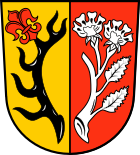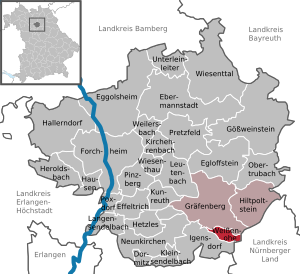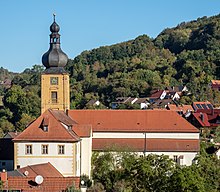Weißenohe
| coat of arms | Germany map | |
|---|---|---|

|
Coordinates: 49 ° 38 ' N , 11 ° 15' E |
|
| Basic data | ||
| State : | Bavaria | |
| Administrative region : | Upper Franconia | |
| County : | Forchheim | |
| Management Community : | Graefenberg | |
| Height : | 358 m above sea level NHN | |
| Area : | 4.7 km 2 | |
| Residents: | 1171 (Dec. 31, 2019) | |
| Population density : | 249 inhabitants per km 2 | |
| Postal code : | 91367 | |
| Area code : | 09192 | |
| License plate : | FO, EBS , PEG | |
| Community key : | 09 4 74 173 | |
| Community structure: | 5 districts | |
| Address of the municipal administration: |
Dorfhauser Strasse 9 91367 Weißenohe |
|
| Website : | ||
| Mayor : | Rudolf Braun (FW / constituency of workers in Weißenohe-Dorfhaus) | |
| Location of the community Weißenohe in the Forchheim district | ||
Weißenohe is a municipality in the Forchheim district ( Upper Franconia administrative region ) and a member of the Graefenberg administrative community .
geography
location
The community is located approx. 25 km northeast of Nuremberg , on the southern edge of Franconian Switzerland . Neighboring towns are Sollenberg, Lilling and Igensdorf . Weißenohe borders on the communities of Gräfenberg , Simmelsdorf , Schnaittach and Igensdorf. The federal highway 2 and the Gräfenbergbahn ( regional train R21) belonging to the transport association Greater Nuremberg run just to the west.
Community structure
The community Weißenohe has 5 districts :
- Village house
- Mönchsberg
- Sonnenberg
- Vineyard
- Weißenohe
Surname
The name Weißenohe is made up of the basic word “aha”, from Germanic and Old High German “ache” (“water”) and the defining word “wizen” (“white”) and means place on the white water or stream. Places with the ending "-aha" are generally ascribed a relatively old age by place name research.
history
Prehistory and early history
There is no reliable knowledge about the earliest history of Weißenohes. Archaeological investigations of the previously known prehistoric graves are still pending. What is certain is that Weißenohe was in the northern part of Bavaria , right on the western border with Eastern Franconia . At this point between Erlangen and Pegnitz , the former political transition zone also coincides with the linguistic-dialectal of the northern Bavarian Westschanke. Weißenohe thus belongs to the transition area of the Nuremberg area with originally Bavarian dialect and later Franconian influence.
The first documented mention of Weißenohes comes from the year 1059, when an Eribo or Aribo de Wizenahe appeared as a witness at a Bamberg diocesan synod.
Middle Ages and early modern times
The remains of the baroque former Benedictine monastery in the center of Weißenohe can be seen from afar. The monastery church of St. Bonifatius , renovated in the mid-1990s, towers over the town with its 45 meter high tower.
The monastery can look back on an eventful history. It was founded - probably towards the end of the 11th century - by the former Count Palatine of Bavaria, Aribo II from the house of the Aribones , who was deposed in 1055 as a Benedictine abbey in the diocese of Bamberg, directly subordinate to the Pope . The first repeal took place in 1554, when the Protestant Palatinate occupied the monastery after the death of the last abbot . About 100 years followed with constant changes of religion: Lutheran, Calvinist, Catholic, until it was re-founded in 1669 by the Bavarian Elector Ferdinand Maria .
Due to its geographical location - Weißenohe and its monastery belonged to the Upper Palatinate for almost all of their 700 years of existence - it protruded almost like a foreign body into the area of the Free Imperial City of Nuremberg . At times it was completely separated from the Upper Palatinate . Nuremberg therefore left no stone unturned in asserting its mostly unjustified claims over the centuries. The Bishop of Bamberg also tried again and again to exert influence. In 1692 the construction of today's monastery church began. The plans come from Wolfgang Dientzenhofer (1648–1706), a member of the famous Upper Bavarian master builder family. On Bonifatiustag in 1707, the church was solemnly consecrated by the Bamberg auxiliary bishop Johann Werner Schnatz. Weissenohe Abbey and its closed Hofmark were the 1803 Electorate of Bavaria secularized . The pastoral care was transferred to the newly created parish, the old monastery church has served as the parish church since then. In the course of the administrative reforms in Bavaria , the municipality of Weißenohe was created with the municipal edict of 1818 .
19th and 20th centuries
The townscape is dominated to this day by the monastery complex, of which the baroque monastery church St. Bonifatius , the former abbot and guest wing, as well as the outlying farm buildings are essentially preserved. The west wing from 1725–1727 probably goes back to Johann Dientzenhofer . The eastern and southern wing of the monastery were demolished around 1840, probably after a fire, and the stones of the old walls were partially built into houses in the village. The monastery and farm buildings as well as the facilities belonging to the monastery (mill, bakery, land, fields, forests, etc.) were sold by the Bavarian state. The Weißenohe monastery brewery , privately run since 1803 and owned by the Winkler family since 1827, is located in the buildings around the courtyard between the gate entrance and the church .
At the turn of the 20th century, important functions, which until then were still located in the complex of the monastery and its adjoining farm buildings to the west, began to be gradually shifted to the area northeast of the cemetery on Dorfhauser Straße. In 1901 the representative parsonage with the parish office was built there. The new school building was opened in 1931, although the primary school was given up again in the 1960s. In 1962/63, the kindergarten with nurses and welfare stations was moved into. In the 1970s, as part of the regional reform in Bavaria, the complex with a community office, fire department and multi-purpose gym followed; In 1998 finally the new kindergarten and the conversion of the old one into a parish hall.
As early as 1886, Weißenohe received a stop on the Erlangen – Graefenberg secondary line and in 1908 the connection to Nuremberg via the Graefenberg railway , which was fundamentally modernized around 2000. Probably in connection with the train station, the Weißenohe roof tiles were built to the west of it in the second half of the 19th century and ceased production in 1991. The monastery brewery and the brickworks were the most important employers in Weißenohe throughout the 20th century, and there were also a number of craft businesses and shops (including two bakeries, two butchers, several corner shops , which gradually cope with the pressure of the supermarkets in the Environment had to give way), while many farms in the narrow valley of the Lillach gave up early. Due to the good transport connections via the Bundesstraße 2 and the railway, most employees have been commuting to Nuremberg since the second half of the 20th century. However, with the new industrial area around the train station, new companies have been able to settle in Weißenohe since the end of the 20th century.
In terms of population development, the end of World War II was the decisive turning point for Weißenohe. The history of Weißenohe under National Socialism has not yet been dealt with, but there are indications that there were considerable divisions within the village. In March 1934 the pillars of the garden fence at the rectory were smeared with printer's ink, Pastor Deppisch was described as a traitor, rascal, spiritual pig and similar expressions. A few days later, windows were broken in the rectory. In 1940 the parish of Weißenohe (with Graefenberg, Lilling, Sollenberg, Mitteldorf, Igensdorf and many smaller towns) still had 1002 souls out of 1625 people of different faiths, so both numbers rose to 1896 Catholics (of which 850 were refugees) and 2493 non-Catholics by 1949. Figures from 1950 are available for today's municipality of Weißenohe: Weißenohe 603, Dorfhaus 199, Mönchsberg 9, Sonnenberg 23, Weinberg 7, a total of 841. The increase in the number of inhabitants in the entire region by refugees and displaced persons by about a third did not only lead to this that up to then fairly clear denominational boundaries (Weißenohe Catholic, village house predominantly Protestant) became less important, but above all that the housing situation was so tense that new housing estates soon sprang up around the old village center. As a result, z. For example, the monastery wing, which was fully inhabited after the war, slowly began to have a real function from the 1970s.
Weißenohe caused a regional sensation with the widespread protest against the attempt of the right-wing extremist NPD to acquire the baroque monastery complex and expand it as a training building. As a consequence of this, an association was founded trying to set up a singing academy in the Weißenohe monastery.
From a cultural point of view there was the nationally known live music club To Act in Weißenohe from 1969 to 1981 . Internationally known artists made regular guest appearances here on the weekends and attracted audiences from all over Middle and Upper Franconia.
21st century
The Kunstraum Weißenohe e. V., who organizes ambitious art exhibitions every summer in the old malthouse of the Weißenohe monastery brewery.
politics
Municipal council
The municipal elections in 2014 and 2020 led to the following allocation of seats in the municipal council:
| Electoral community of workers Weißenohe-Dorfhaus | Free electoral community Weißenohe-Dorfhaus | Independent voter community Weißenohe-Dorfhaus | Green | total | |
| 2014 | 4th | 4th | 3 | 1 | 12 seats |
| 2020 | 4th | 3 | 2 | 3 | 12 seats |
mayor
The first mayor has been Rudolf Braun (Free Voters / Wahlgemeinschaft der Arbeiter Weißenohe-Dorfhaus) since 1996, and Raimund Schwarz held the post of second mayor from 2008 to 2020. His successor is Marc-Andre Schuhmann (SPD / Wahlgemeinschaft der Arbeiter Weißenohe-Dorfhaus). The third mayor is Thomas Windisch (Independent Voting Association).
coat of arms
The description of the coat of arms reads: "Split of gold and red, in front an upright black deer pole, which is decorated with a red heraldic lily on top, behind a silver cherry branch with two flowers and two leaves."
Attractions
In addition to the monastery and its baroque church, the valley of the Lillach with the nature reserve around the sintered terraces of the Lillach between Lilling and the village house is particularly worth seeing. The so-called Burgstall Hainburg , built in the 11th or 12th century and abandoned early, probably as early as the 13th century, is integrated into the hiking trails starting from Weißenohe on the mountain spur of the cat via Mitteldorf and Unterrüsselbach.
Economy and tourism
- The Weissenohe monastery brewery with the attached restaurant and beer garden in the old cloister courtyard is of particular economic and tourist importance for Weißenohe.
- An energy competence center has been located here since 2008. Once a year the solar day is held in Weißenohe.
- The Fünf-Seidla-Steig is a hiking trail opened in 2008 between the four breweries in the municipality of Gräfenberg and the Weißenohe monastery brewery. It is named after the Franconian beer mug, the Seidla . The breweries produce a total of 21 different beers.
literature
- Tilmann Breuer: City and District Forchheim. Brief inventory. (= Bavarian art monuments; 12). German Kunstverlag, Munich 1961, pp. 208–214.
- Johann Kaspar Bundschuh : Weissenau . In: Geographical Statistical-Topographical Lexicon of Franconia . tape 6 : V-Z . Verlag der Stettinische Buchhandlung, Ulm 1804, DNB 790364328 , OCLC 833753116 , Sp. 141-142 ( digitized version ).
- Markus Naser: Weißenohe . In: Michael Kaufmann et al. (Ed.): The Benedictine monasteries for men and women in Bavaria, St. Ottilien 2014, Volume 3, pp. 2481–2497.
- Ursula Pechloff: Weißenohe, St. Bonifatius. Former Benedictine monastery church. Ed .: Catholic Parish Office Weißenohe. Photographs Gregor Peda. (Peda art guide; No. 425). Kunstverlag Peda , Passau 1998, ISBN 3-89643-081-5 .
- Hubert Pöppel: On the early history of the place and the Weißenohe monastery. In: Report of the Historisches Verein Bamberg (BHVB) 149, 2013, pp. 93–136.
- Josef Pöppel: Weißenohe: On the history of the monastery and parish. Norderstedt 2013, ISBN 3-7322-3580-7 .
- Karl Puchner: The oldest name tradition of the Weißenohe / Ofr. In: Blätter für die Oberdeutsche Namenforschung 2, 1/2, 1959, pp. 35–45.
- Hans Räbel: The former Benedictine aristocratic monastery Weißenohe in the period from the Landshut War of Succession to the rebuilding (1504–1669), together with an appendix about the prehistory of the monastery. In: Report of the historical association for the care of the history of the former prince-bishopric of Bamberg (BHVB) 66, 1908, pp. I – XXI and 1–586.
- Pleikard Joseph Stumpf : Weissenohe . In: Bavaria: a geographical-statistical-historical handbook of the kingdom; for the Bavarian people . Second part. Munich 1853, p. 586 ( digitized version ).
Web links
- Homepage of the community
- Entry on the coat of arms of Weißenohe in the database of the House of Bavarian History
- Weißenohe: Official statistics of the LfStat
- Parish of St. Boniface
- Katharina Wolff: Fund: Weißenohe monastery documents (with section The Benedictine Abbey of St. Boniface in Weißenohe as an introduction to the Weißenohe documents from 1109 to 1612) in the European document archive Monasterium.net .
- Weissenohe Monastery Choir Academy
- The traditional inn in the monastery brewery
- Brewing culture in the Weißenohe monastery brewery
- Weißenohe art space
Individual evidence
- ↑ "Data 2" sheet, Statistical Report A1200C 202041 Population of the municipalities, districts and administrative districts 1st quarter 2020 (population based on the 2011 census) ( help ).
- ^ Community Weißenohe in the local database of the Bavarian State Library Online . Bayerische Staatsbibliothek, accessed on January 5, 2020.
- ↑ Ernst Schwarz. Language and settlement in northeast Bavaria . Nuremberg 1960, p. 116.
- ↑ Following the Bavarian Monument Atlas , there are two prehistoric burial mounds between the village house and Oberwindsberg and a Hallstatt period burial mound field between the village house, Sollenberg and Lilling.
- ↑ Cf. Hugo Steger: Language area formation and regional history in eastern Franconia . Neustadt / A. 1968, pp. 543-547.
- ↑ Erich von Guttenberg: The regests of the bishops and the cathedral chapter of Bamberg . Würzburg 1932, Reg. 312.
- ↑ See Pechloff and also J. Pöppel.
- ^ Archive of historical roof tiles ; since then the building has been used by a toy company.
- ^ Andreas Stefan Hofmann: Resistance of the Catholic milieu against the NSDAP in the Upper Franconian district of Forchheim 1920-1933 In: Report of the Historisches Verein Bamberg (BHVB) 151, 2015, pp. 259-303
- ↑ Josef Pöppel: Weißenohe: On the history of the monastery and parish. Norderstedt 2013, ISBN 3-7322-3580-7 , p. 79
- ↑ Josef Pöppel: Weißenohe: On the history of the monastery and parish. Norderstedt 2013, ISBN 3-7322-3580-7 , p. 81.
- ↑ Ingomar Bog : Forchheim (= Historical Atlas of Bavaria, Part Franconia . I, 5). Komm. Für Bayerische Landesgeschichte, Munich 1955, DNB 450540367 , p. 136 ( digitized version ).
- ↑ NN Online ( Memento of the original from June 12, 2008 in the Internet Archive ) Info: The archive link was automatically inserted and not yet checked. Please check the original and archive link according to the instructions and then remove this notice. Nürnberger Nachrichten 200 neo-Nazis - and a village in Upper Franconia in rebellion . June 7, 2008.
- ^ To Act, former live music club in Weißenohe
- ↑ https://web.archive.org/web/20200617152530/https://www.verwaltungsgemeinschaft-graefenberg.de/wahlen/Wahl-2020-03-15/09474173/html5/Gemeinderatswahl_Bayern_20_Gemeinde_Gemeinde_Weissenohe.html Web archive: election results Weißenohe
- ^ SPD local association Weißenohe: Marc-André Schuhmann is 2nd mayor. May 17, 2020, accessed June 17, 2020 .
- ↑ Franken-Wiki.de , Fünf-Seidla-Steig







